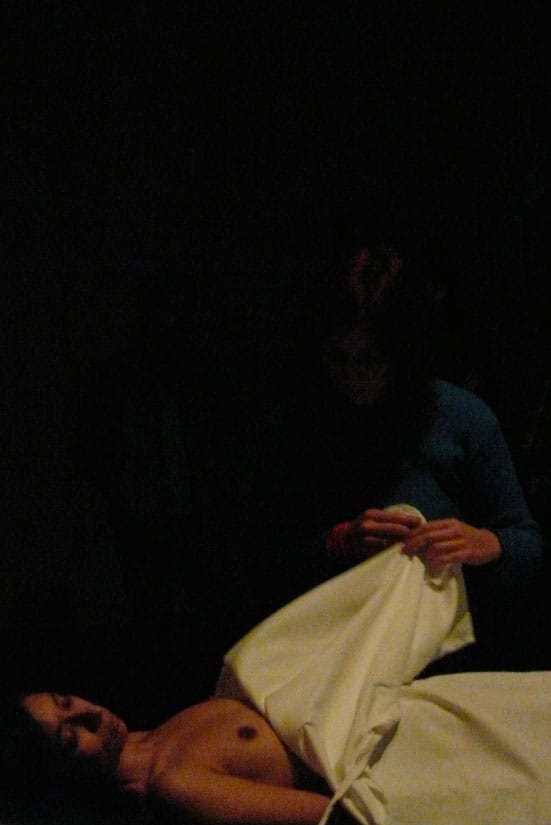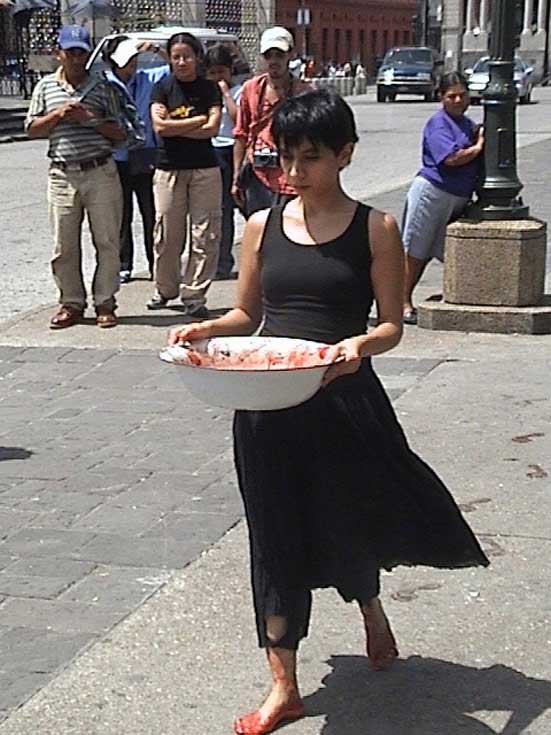Visitors to Regina José Galindo’s latest exhibition in Oxford may be right to enter with some trepidation. Here is an artist whose rise to international acclaim included filming a close-up of hymenoplasty (for which she was later hospitalised); getting dumped in a body bag like so many victims of violence in Central America; and crawling into a tiny brick sculpture to lash her body 279 times – one for each of the women murdered in her home country in 2004.
Modern Art Oxford is showing a number of works by the diminutive Guatemalan performance artist in the Upper galleries. The display – her first solo show in the UK – includes the now famous video Who can erase the traces? (2003), which documents Galindo’s walk from the Supreme Court to the National Palace in Guatemala City, carrying a bowl of blood and leaving red imprints of her feet along the way. This work was made in response to the Court’s decision to allow the infamous General Ríos Montt to run in the 2003 presidential election. The General had led the 1982-3 vicious assault on Guatemala’s indigenous, Mayan groups, which left thousands dead, and many more homeless.
The central gallery space includes two other large video projections showing I’ll shout it into the wind from 1999 where the artist is suspended in a harness from an arch in Guatemala City, clad in a white dress like some low-tech vision of an angel, reading aloud from her poems, her voice imperceptible over the constant din of traffic and urban noise. The poems fall to the ground, unheard. The third projection, The Fashionable Cut (2005) depicts Venezuela’s top plastic surgeon sketching his ideal alterations onto Galindo’s naked body, suggesting the absurdity of contemporary standards of feminine beauty.
While this later work appears more playful, violence is a notable feature of Galindo’s work – as the artist notes ‘I live in a violent country, and that’s where my violent art comes from.’ Some of the works appear almost as a cathartic reaction to harrowing events in Guatemala’s recent history; using self-harming as a mechanism to empathise and deal with the pain inflicted on others, whether she is subjecting herself to incarceration, simulating drowning at the hands of a grim volunteer torturer or recreating the posture of pregnant women as they are gang-raped by soldiers. This approach of so clearly referencing the body of others sets Galindo apart from many practitioners in the field performance art, who may use the body in a similar way, but employ more self-referential points of departure.
As well as responding to domestic conditions, much of Galindo’s work deals with the relationship between what she calls the ‘First’ and the ‘Third’ world, particularly the relationship between Central American countries and the United States, whether in terms of illegal migration towards the North, or C.I.A. complicity in the bloody history of its neighbours in the South. In a new commission for Modern Art Oxford, Galindo uses the example of the international trade in human hair, as perpetuating the power dynamics between the purchasers of wigs in the First World and the poverty in part of the Indian subcontinent which forces women to sell their hair. The work includes a wig of natural hair on a pole, juxtaposed with a painted photograph of the same. The work appears oddly sterile set against the backdrop of the hard-hitting emotive force of the other works in the exhibition.
Galindo appears increasingly interested in audience reactions, and the extent to which these are culturally determined. A large video projection shows the artist anesthetised and naked under a blanket, seemingly in a morgue. The audience’s responses range from keeping their distance to carefully lifting the blanket, and examining the body before reeling away from the corpse-like figure. The extent to which the responses are gendered is fascinating. In Warm-Up, the performance conducted at the Ruskin School of Drawing this January, saw the artist impose her own cultural stereotype onto visitors, seeking to bring about closer interaction among ‘cold’ British people by subjecting them to the hot and humid conditions of her homeland. In a performance conducted in Norway earlier this year she, in a similar way, tacitly challenged the audience to overcome their reserve to cover the naked figure, shivering in the cold gallery space as temperatures outside dropped to minus 12 degrees Celsius.
Galindo’s has been prolific in her relatively short career, stretching just over a decade. Some works tend towards the literal, using metaphor to reinforce metaphor. Most leave a haunting impression of poetry in motion, evoking the pain and suffering of others, whose voices would otherwise go unheard.
Dates: 31 January – 29 March 2009
Times: Tuesday to Saturday 10am – 5pm. Sunday 12noon – 5pm. Free
Address: Modern Art Oxford, 30 Pembroke Street, Oxford, OX1 1BP
Natalie Hope O'Donnell

Regina José Galindo ‘Limpieza Social’
2006, Il Pottere Delle Donne, Galeria Cívica Nacional, Trento, Italia
Photo: Hugo Muñoz. Courtesy the artist & prometeogallery di Ida Pisani

Regina José Galindo ‘Reconocimiento de un cuerpo’
2008, Argentina
Photo: David Pérez. Courtesy the artist & prometeogallery di Ida Pisani

Regina José Galindo ‘Quién puede borrar las huellas?’
2003, Guatemala
Photo: Victor Pérez. Courtesy the artist & prometeogallery di Ida Pisani